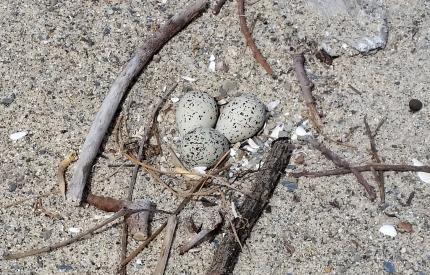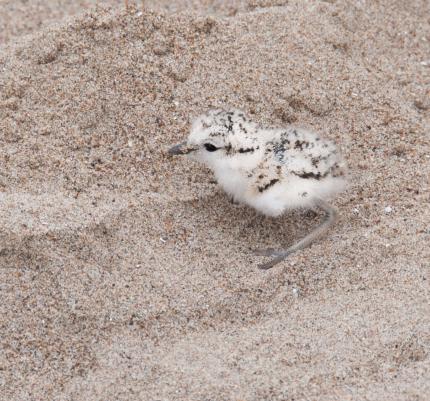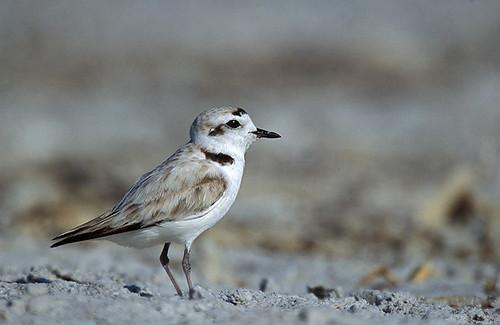Moderate-
High
Snowy plovers are small, sand-colored shorebirds that nest directly on the sand. Chicks hide and forage in the wrack line (the seaweed-filled high tide line). Washington's snowy plover population is very small and vulnerable to a variety of impacts, such as predators, adverse weather driven by climate change, shoreline modification, dune stabilization, and recreational activities.
Nests and chicks depend on their camouflage to survive – but it also makes them vulnerable to human disturbance including vehicles, dogs, and accidental trampling.
Help keep plovers and other coastal wildlife safe:
- Respect closures: Do not walk into the dunes beyond posted closure signs.
- If on a driving beach:
- Drive slowly: the beach speed limit is 25 mph. This speed protects plovers and migratory shorebirds.
- If possible, try to drive in the wet sand below the wrack line.
- Do not drive in the wrack line between June and August: tiny plover chicks hide in the seaweed.
- Dogs + Birds = Problems. Keep dogs close to you and away from nesting areas. Please consider keeping your dog on-leash during the nesting season, even if leashes are not required.
- Leave no trace. Pack out any food and trash. Food waste attracts plover predators like crows, ravens, and coyotes.
- Keep the skies clear. If possible, try not to fly a kite or drone above or around plover nesting areas. Plovers can mistake them for airborne carnivores, which causes them stress.
Description and Range
Physical description
The snowy plover is about 6 inches in length. It is pale brown or grayish above and has a white underside. It has a black bill. Legs are dark. A breeding male has a black headband, blackish ear patch and partial black breast band; a breeding female’s markings are less distinct. Non-breeding adults and juveniles are paler overall.
Ecology and life history
In Washington, snowy plovers are found (in any season) on coastal beaches, sand spits, dune-backed beaches, and sparsely vegetated dunes.

Snowy plovers forage on a variety of invertebrates found at coastal intertidal areas.
Snowy plovers nest on the ground on broad open beaches or salt or dry mud flats, where vegetation is sparse or absent. Chicks leave the nest soon after hatching, and they use small clumps of vegetation for cover. Chicks are tended by both parents (or male only), and the female often then abandons its first mate and brood within a few days to re-nest with a new mate.

Predation by American crows, common ravens, coyotes, and occasionally other predators may result in a high rate of clutch loss (eggs and chicks) in some areas.
Geographic range
The Pacific coast breeding population of snowy plovers extends from Washington to northwestern Mexico. Some are found further south during the winter months. In Washington, the species is found only in Pacific and Grays Harbor counties.
The Washington population consists of approximately 100 adult birds, and may be dependent on immigration from Oregon. Populations are responding to intensive conservation efforts, but viability analysis indicates that the Pacific coast population is unlikely to reach the federal recovery objective of 3,000 birds.
For maps of range-wide distribution and conservation status of this species, check out NatureServe Explorer and the International Union for Conservation of Nature Red List.
Climate vulnerability
Sensitivity to climate change
High
The dependence of western snowy plovers on coastal beaches as habitat for breeding and nesting increases their sensitivity to climate change. Sea level rise, beach erosion, and storm surges may cause declines in suitable habitat and decreases in local carrying capacity. Additionally, increased rainfall, seasonal wind, and storms could lead to declines in nesting success. Even without a loss of habitat, seasonal storms that wash over breeding areas will cause nest failure; this happens now with essentially benign weather patterns.
Exposure to climate change
Moderate
- Sea level rise
- Increased coastal erosion
- Increased storminess/storm surge >
Conservation
Conservation Threats and Actions Needed
- Habitat loss or degradation
- Threat: Loss of habitat due to the introduction of non-native American and European beach grasses. Approximately 90 percent of snowy plover habitat has been lost across its breeding range.
- Action Needed: Continue programs to enhance nesting habitat by removing beach grass in key areas.
- Threat: Human disturbance caused by recreation; beach walkers, unleashed dogs, cars.
- Action Needed: Continue efforts to reduce disturbance to areas used by plovers, including posting signage around protected areas and encouraging compliance by beachgoers.
- Problematic native species
- Threat: Nest predation by corvids such as American crows and common ravens.
- Action Needed: Control nest predation; continue ongoing predator management program.
- Resource information collection needs
- Threat: Information gaps about snowy plovers
- Action Needed: Continue annual surveys conducted during breeding and winter periods.
See the Climate vulnerability section above for information about the threats posed by climate change to this species.
Our Conservation Efforts
WDFW has conducted monitoring surveys and research of the snowy plover population in Washington for multiple decades in cooperation with U.S. Fish and Wildlife Service. In 2013, a predator management strategy that included direct hazing and removal of crows and ravens, the main nest predators, was initiated on Washington nesting beaches and may be contributing to improved nesting and fledging success in recent years. In 2024, WDFW initiated a study to understand predator management strategies and how they relate to plover nesting and fledging success.
According to the Washington State Recovery Plan for the Snowy Plover, the species will be considered for down listing to threatened when the state supports a 4-year average of at least 25 breeding pairs that fledge an average of at least one young per adult male per year at two or more nesting areas with “secure” habitat.
As of Spring 2024, the 4-year average was between 35-41 breeding pairs, exceeding recovery goals. The 2024 breeding season also estimated an average of 1.03 fledged chicks per male averaged across monitored sites, barely above recovery goals. Gaps in monitoring do not allow for full confidence in that metric, however.
The population estimated exceeded 100 individual adults for the first time in 2024, with an estimate of 123 breeding adults. However, challenges persist. A population viability analysis suggested that the West Coast population would not reach the recovery objective of 3,000 individuals identified in the federal recovery plan without additional habitat restoration. As a result, control of beach grass and management to reduce human disturbance are ongoing. Although the snowy plover population in the region appears to be increasing as a result of management actions in Washington and Oregon, the species in Washington is still state listed as endangered.
Watch this video about the life history of snowy plovers and species recovery efforts by the U.S. Fish and Wildlife Service, Bureau of Land Management, and the State of Oregon and learn what people can do to share the beach with this special bird.
Resources
Resources
Anholt, A., M. Cent, S. Amburgey, W. Ritchie, C. Sundstrom, and L. Pfleeger-Ritzman. 2025. Washington State Snowy Plover Population Monitoring, Research, and Management: 2024 Nesting Season Research Progress Report. Washington Department of Fish and Wildlife, Montesano, Washington.
USFWS. 2007. Recovery plan for the Pacific coast population of the western snowy plover (Charadrius alexandrinus nivosus).
USFWS, Sacramento, California. WDFW. 1995. Washington State recovery plan for the Snowy Plover. Olympia, Washington.
WDFW publications
Status reports
Recovery plans
Population monitoring, research, and management
- Washington State Snowy Plover Population Monitoring, Research, and Management: 2013 Nesting Season Research Progress Report
- Washington State Snowy Plover Population Monitoring, Research, and Management: 2012 Nesting Season Research Progress Report
- Washington State Snowy Plover Population Monitoring, Research, and Management: 2011 Nesting Season Research Progress Report
- Washington State Snowy Plover Population Monitoring, Research, and Management: 2010 Nesting Season Research Progress Report
- Washington State Snowy Plover Population Monitoring, Research, and Management: 2009 Nesting Season Research Progress Report
- Snowy Plover Population Monitoring, Research, and Management Actions: 2008 Nesting Season Research Progress Report
- Snowy Plover Population Monitoring, Research, and Management Actions: 2007 Nesting Season Research Progress Report
